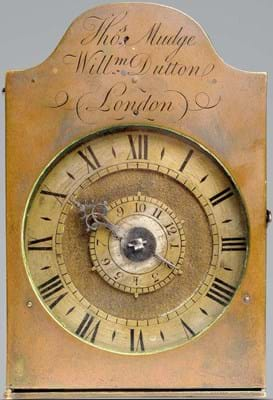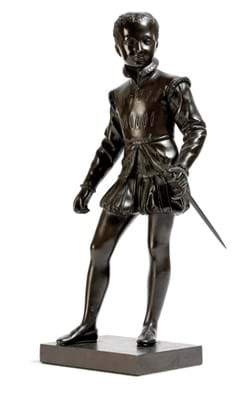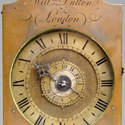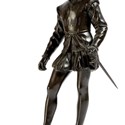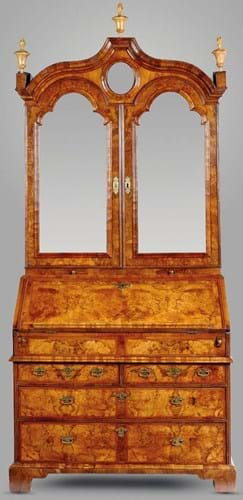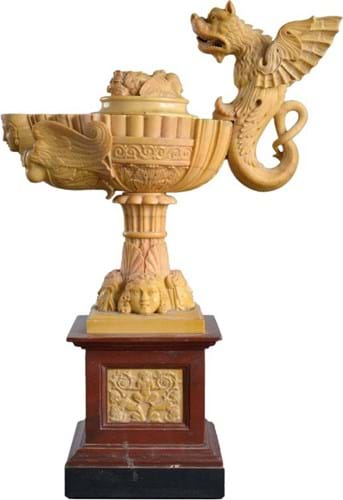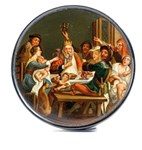The sale at Woolley & Wallis (25% buyer’s premium) at Salisbury on January 10, a traditional season opener, resulted in 85% of the 700 lots selling to a total just over £504,000 – but with occasional sticky areas among the furniture and longcases.
Meanwhile, the enthusiasm for affordable antiques was never more evident than at Lincoln’s Unique Auctions, where on New Year’s Day itself more than 1600 bidders took part in an 11-hour auction marathon (see separate story).
Longcase leads
Against the current grain it was a longcase clock which led the day in Salisbury. This was the illustrated 7ft 8in (2.03m) tall William and Mary walnut longcase clock with a long-duration movement signed Gulielmus Clement Londini Fecit.
William Clement is not the most familiar name among the Golden Age makers but is highly regarded.
Clement (who, incidentally, started working life in London making anchors for local Rotherhithe shipbuilders) was one of the earliest makers to apply the anchor escapement to clockwork, thus making long pendulums practicable. This month-going brass movement featured a recoil anchor escapement. Estimated at £30,000-50,000, the clock went to the trade at £38,000.
There were other four-figure longcase successes but the projected star, with an eight-day brass movement signed twice Geo. Graham London and numbered 670, failed to get away at its £40,000-60,000 estimate.
An associated walnut case – even one possibly produced by Daniel Delander’s workshop – counted heavily against it. A £15,000- 20,000 estimate was also a bit strong for bidders on a 6ft 10in (2.1m) tall, eight-day William and Mary marquetry longcase signed to the plaque John Knibb Oxford, but it got away at £12,000.
It fared better than a similar clock by Knibb’s one-time apprentice. Signed to the silvered chapter ring John Foorde Oxon, this failed to sell against hopes of £10,000-15,000.
As so often at sales where the older generation shake their heads sadly at longcase prices, there was considerable compensation when it came to smaller clocks, most notably at Salisbury in the example of a George III travelling alarm timepiece.
In a 5¼in (13.5cm) brass case with sliding dust shutters, the 30- hour movement was inscribed to a hinged outer plate Thos Mudge, Willm Dutton, London.
Mudge (1717-94), one of Graham’s apprentices, is better known as one of Britain’s finest watchmakers. Dutton, another Graham apprentice, became his partner in c.1750. The estimate looked very tempting at £1000-1500 and it sold to the trade at £9800.
Furniture results
Much of the furniture at Salisbury got away against realistically low estimates. George III mahogany remains remarkably underappreciated, although some private buyers are taking advantage.
“We seem to be selling more and more directly to private buyers,” said W&W furniture expert Suzy Becsy.
Furnishers took a very pretty little kneehole desk with brushing slide, 2ft 7in (79cm) wide, at £550; a serpentine card table at £600 and a bureau with fitted interior and pair of secret pilaster compartments at £500.
More encouragingly, a number of chairs did well.
Among them was a pair of late George III mahogany hall chairs, the backs carved with a double headed eagle, which took a six-times estimate £3400; a George II and later walnut wing armchair went within expectations at £4500, and a Charles II oak panelled back stool with strapwork and carving took £1800 against a £300-400 estimate.
Howard armchairs continue to be in demand. A late 19th century example, with H&S monogrammed ticking and stamped Howard & Sons Ltd. Berners St., quadrupled expectations when it went to the trade at £3200.
Dealers took much of the better-selling furniture, including the top lot – a George I walnut and burr walnut bureau bookcase. Standing 7ft 4in (2.23m) tall, the crossbanded and featherbanded bookcase featured candle slides and a stepped fitted interior with a sliding well cover.
Against a £6000-8000 estimate, it went to the trade at £9800, a decent sum these days, so perhaps there is little point in reflecting that back in 2002 it made £12,000 hammer at Christie’s.
Decorative delights
The more esoteric and decorative areas, in particular, impressed.
The outstanding decorative item was a Grand Tour piece, a mid-19th century Italian Siena marble model after the antique of a Roman lamp.The 15in (38cm) lamp was formed as a winged Pharaonic female figure with an owl and a detachable griffin handle.
Estimated at £1000-1500, it was a trade buy at £18,000.
French and Italian bronzes sold solidly, including a group of Psyche Awakening Cupid signed by Albert- Ernest Carrier-Belleuse (1824-87), a founder member of the Société Nationale des Beaux-Arts but probably most mentioned these days as the man who employed Auguste Rodin as his assistant for six years.
The 17 x 21in (44 x 53cm) group on a verde antico marble base sold to the trade on the lower estimate at £5000.
Also selling at £5000 – but in this case to a collector and against hopes of £600-800 – was a bronze which Arthur George Walker (1861-1936) exhibited at the Royal Academy in 1903. Titled The Thorn, the figure of a female nude standing on a rocky outcrop stood 21in (54cm) on a green marble plinth and was signed with the monogram AGW.
Among the earliest English material was a rare silk and silver thread picture by Mary Sibley dated 1670 showing Mary and her two sisters standing in a gallery below a canopy with tassels, with a cityscape, possibly London, in the distance.
Measuring 5 x 7in (14 x 18cm) in a later glazed ebonised wood moulded frame, it was estimated at £600-800 but sold at £4800.
Four pieces of George III Blue John left estimates behind. Topping the three was an 8½in (22cm) tall campana-shape urn, on a stepped black marble plinth which tripled top hopes at £3800.



